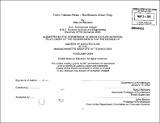| dc.contributor.advisor | Rahul Mehrotra. | en_US |
| dc.contributor.author | Kikutake, Natsuko | en_US |
| dc.contributor.other | Massachusetts Institute of Technology. Dept. of Architecture. | en_US |
| dc.coverage.spatial | n-us-ma | en_US |
| dc.date.accessioned | 2009-10-01T15:49:12Z | |
| dc.date.available | 2009-10-01T15:49:12Z | |
| dc.date.copyright | 2009 | en_US |
| dc.date.issued | 2009 | en_US |
| dc.identifier.uri | http://hdl.handle.net/1721.1/47835 | |
| dc.description | Thesis (M. Arch.)--Massachusetts Institute of Technology, Dept. of Architecture, 2009. | en_US |
| dc.description | Includes bibliographical references (p. 90-92). | en_US |
| dc.description.abstract | The formal architectural language of existing public transit can be categorized into one of the following four architectural prototypes: form follows function, the duck, the decorated shed, and the inverted decorated shed. This thesis presents a fifth prototype which involves a kinetic and dynamic approach to design. Coined as, "Form Follows Flows," this approach allows architectural form to be responsive and adaptive to the dynamics of its users and environment. By bridging the disciplines of Urban Planning, Urban Design and Architecture, the thesis investigates design solutions to the issues of urban mobility and complex urban networks (of pedestrians, trains, bicycles, cars, buses, goods, etc.). The opportunity adopted in this exploration is the Boston Urban Ring Bus Rapid Transit proposal. The project presents major socioeconomic opportunities both at the urban and architectural scale for the City of Cambridge and the Massachusetts Institute of Technology. The design proposal is a mixed-use transit hub, which will layer disparate programs such as a transit station with institutional, residential and commercial uses, thereby generating a 24-7 activated space in the center of the MIT campus. The spatial conditions are informed by the evolving fluxes and flows of users, which change according to time, season and program. Furthermore, the thesis explores the urban implications of architecture that can adequately transform in response to evolving programmatic demands and changes in the surrounding built environment. This thesis constitutes the final component for the author's completion of the Master of Architecture degree in conjunction to the interdepartmental Urban Design Certificate. | en_US |
| dc.description.statementofresponsibility | by . | en_US |
| dc.format.extent | 93 p. | en_US |
| dc.language.iso | eng | en_US |
| dc.publisher | Massachusetts Institute of Technology | en_US |
| dc.rights | M.I.T. theses are protected by
copyright. They may be viewed from this source for any purpose, but
reproduction or distribution in any format is prohibited without written
permission. See provided URL for inquiries about permission. | en_US |
| dc.rights.uri | http://dspace.mit.edu/handle/1721.1/7582 | en_US |
| dc.subject | Architecture. | en_US |
| dc.title | Form follows flows -- the Boston urban ring | en_US |
| dc.title.alternative | Boston urban ring | en_US |
| dc.type | Thesis | en_US |
| dc.description.degree | M.Arch. | en_US |
| dc.contributor.department | Massachusetts Institute of Technology. Department of Architecture | |
| dc.identifier.oclc | 429904939 | en_US |
